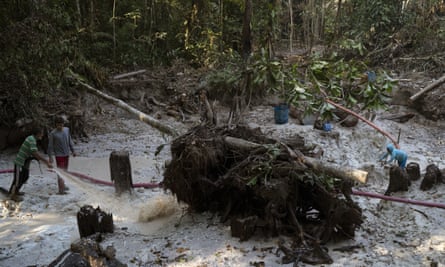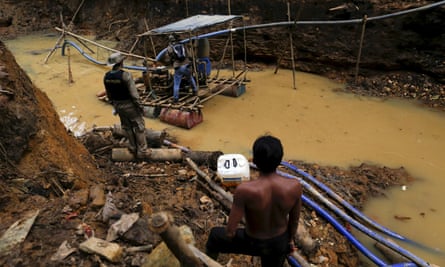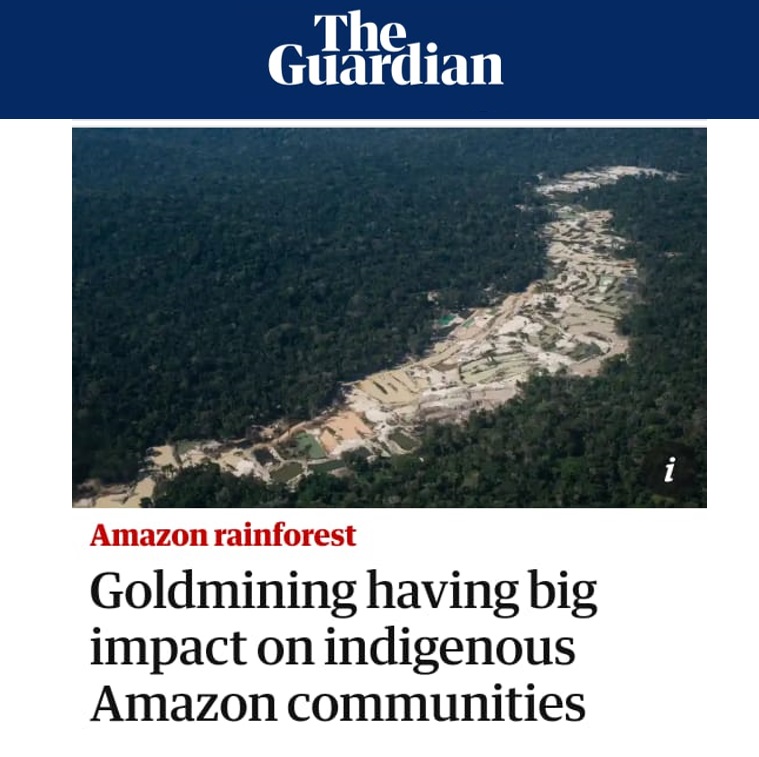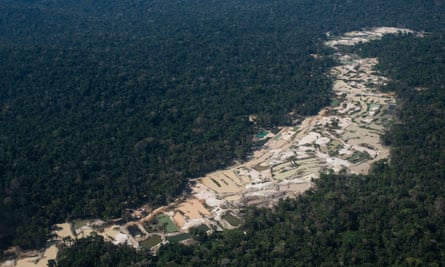A new report has exposed the scale and impact of mining on indigenous reserves in Amazon countries as gold prices soared during the Covid-19 pandemic. More than 20% of indigenous lands are overlapped by mining concessions and illegal mining, it found, covering 450,000 sq km (174,000 sq miles) – and 31% of Amazon indigenous reserves are affected.
The report, released on Wednesday by the World Resources Institute, said indigenous people should be given more legal rights to manage and use their lands, and called for better environmental safeguards. As pressure mounts over the issue, a leading Brazilian thinktank has called for regulations tracing gold sold by financial institutions.
“The extent of mining concessions and illegal mining areas that overlap indigenous areas in the Amazon is much more significant than many people thought,” said Peter Veit, director of the WRI’s Land and Resource Rights Initiative, and one of the report’s authors. It used geospatial analysis and literature and science reviews, and estimated that half a million small-scale goldminers are active in the Amazon region.
Only half of legal mining concessions in the Amazon are active, Veit said. But with mining seen by many Amazon countries as key to development, that could change. In Brazil, the government of the far-right president, Jair Bolsonaro, has sent a bill to Congress to formally legalise mining on protected indigenous reserves.
“The implications for the environment and for indigenous peoples could significantly increase if those concessions that have yet to be allocated were to start up,” Veit said.
Rising gold prices – which hit nearly $2,100 (£1,625) an ounce in August – have helped to drive wildcat miners into the Amazon. “Gold prices had been rising for years but the threat to economies from the novel coronavirus led to a surge in prices – up about 35% this year – as investors sought the perceived safety of gold. As prices rise, so does demand and mining,” the report said.

Miners work in a ravine at an illegal gold mine in the Itaituba area of Pará state, Brazil. Photograph: Lucas Dumphreys/AP
In Brazil, invasions of indigenous lands by garimpeiros – as wildcat miners are called – have increased since Bolsonaro took office in January 2019. Many voted for Bolsonaro after he promised to legalise their work. In 2019, deforestation caused by garimpeiros in the Amazon rose 23% on 2018 to a record 10,500 hectares (26,000 acres), O Globo newspaper reported in May, following a freedom of information request to the environment agency Ibama.
Army operations have failed to clear tens of thousands of miners from Brazil’s biggest indigenous reserve, the Yanomami. From October 2018 to March 2020 alone, nearly 2,000ha were degraded by mining in the reserve, the report said.
The Munduruku Indigenous Reserve in the Brazilian Amazon state of Pará has been heavily affected. Garimpeiro investors have paid local indigenous people to help them enter the reserve and work within it, said Ademir Kaba Munduruku, a local leader. “This has been imitated by other Munduruku and become a big problem,” he said. “Alcoholism, prostitution, drugs, violence, division within the Munduruku people, contamination of river beds have all increased.”
Federal prosecutors are investigating whether a Brazilian air force plane flew indigenous garimpeiros from his region to Brasília for a meeting with the environment minister, Ricardo Salles, during a military operation to control illegal mining, following media reports. The operation was suspended.
The Brazilian thinktank Instituto Escolhas (Choices Institute) has opened a public consultation for a proposal it will present to Brazil’s central bank and the Securities and Exchange Commission to regulate gold purchases, the Folha de S.Paulo newspaper reported. Garimpeiros presently just need to show ID and sign a form, it said. Brazilian gold exports rose 35% from January to August, hitting $3bn, Folha said.

A member of the Yanomami community watches as Brazil’s environmental agency Ibama closes down an illegal goldmine in Roraima state, Brazil. Photograph: Bruno Kelly/Reuters
Legal mining can also come at a high cost, Veit said. “Many companies don’t adhere to the law, the letter of the law, many don’t seem to adhere to their agreements with the government,” he said. Case studies from Peru and Ecuador document legal struggles between indigenous groups, governments and mining companies.
In Guyana, Patamona indigenous people from Campbelltown involved in artisanal mining have “shown some willingness” to work in a more sustainable way, banning mercury and rehabilitating mining sites, the report said.
During a virtual press conference on Wednesday, Michael McGarrell, human rights coordinator for the Amazon indigenous organisation COICA, said his Patamona indigenous people in Guyana had long practised traditional, low-impact, artisanal mining. “Our people were mining before anyone came; however, it was done in a way that [meant] it had minimal impact and it continues to this day,” he said.
But Amazon indigenous peoples lose out when mining companies and illegal operations enter their land. “We are under siege from legal and illegal mining and our governments are doing little to enforce the rights that do exist,” McGarrell said.
Publicada originalmente em:https://www.theguardian.com/environment/2020/oct/07/goldmining-having-big-impact-on-indigenous-amazon-communities

 Texto
Texto


